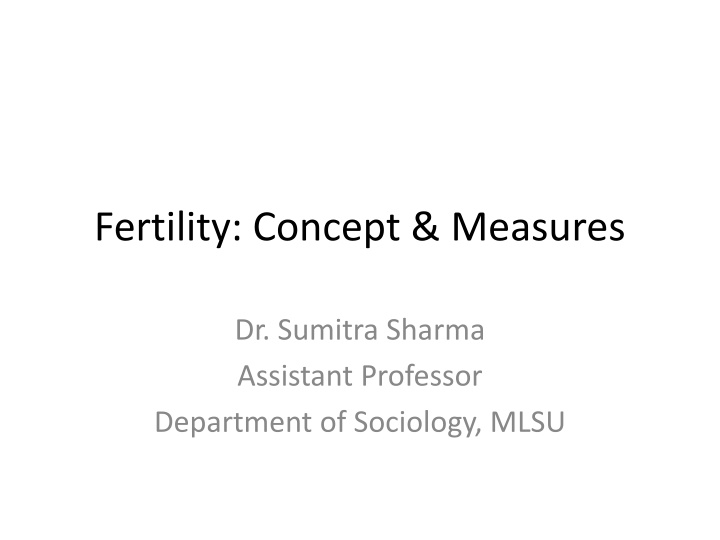
Fertility Measures in Population Dynamics
Explore the concepts of fertility and fecundity, and learn about the measures used to analyze fertility in populations. Discover the difference between fertility and fecundity, and delve into direct and indirect measures of fertility analysis like the Crude Birth Rate (CBR).
Download Presentation

Please find below an Image/Link to download the presentation.
The content on the website is provided AS IS for your information and personal use only. It may not be sold, licensed, or shared on other websites without obtaining consent from the author. If you encounter any issues during the download, it is possible that the publisher has removed the file from their server.
You are allowed to download the files provided on this website for personal or commercial use, subject to the condition that they are used lawfully. All files are the property of their respective owners.
The content on the website is provided AS IS for your information and personal use only. It may not be sold, licensed, or shared on other websites without obtaining consent from the author.
E N D
Presentation Transcript
Fertility: Concept & Measures Dr. Sumitra Sharma Assistant Professor Department of Sociology, MLSU
What is Fertility Fertility, one of the three components of population dynamics (the others being mortality and migration), holds a very important place in any population study. A positive force in population dynamics, fertility is responsible for biological replacement and continuation of human society. Fertility levels determine population, which in turn governs the social, economic and demographic characteristics of the population. The interest in the study of fertility also arises because it is a very complex phenomenon affected by a host of social, cultural, psychological, economic and political variables. the age structure of a
Continue. Fertility refers to the number of live births relating to a woman, or a group of women. fertility depends on many factors such as nutrition, endocrine system of the organism, behavioral patterns, socio-economic patterns and time, etc. Fecundity:-Fecundity is not a natural phenomenon. Fecundity is the potential for reproduction, especially in the female organism. It is also called the biological capacity to reproduce. fecundity depends on the genetics of an individual and environmental factors.
Difference between fertility & Fecundity In reproductive health, the terms fertility and fecundity play major roles. These two concepts are widely used in population ecology. In most cases, fertility and fecundity explain processes in mammalian systems fertility is the natural ability of an organism (male or female) to reproduce reproductive capacity of population. The fertility rate of a female depends on the number of births. On the other hand, fecundity is the potential specifically in a female to reproduce. while a fecundity single is the person or a
Measures of Fertility Analysis: Fertility measures are devices to quantify the fertility performance of a population over a period of time. . These measures are used to compare fertility behaviour of different populations, and to examine the trends in fertility of a population over a period of time. These measures can be grouped into two categories:- Direct measures: data on live births are directly used Indirect measures: estimate is indirectly arrived at using some other demographic characteristics such as age distribution of population. Indirect measure is recourse when direct data on number of live births are either inaccurate or unavailable.
Conti.... Direct Measures:Crude Birth Rate (CBR) is one of the most commonly used measures of fertility because of its simplicity in concept and measurement. It is the ratio between the total registered live births in a population during a calendar year CBR is calculated in the following manner: CBR= (B/P) K (8.1) , B is the number of live births in a calendar year, P is the mid-year population, and K is a constant, which is generally taken as 1,000 in all the measures except otherwise mentioned. CBR is thus the number of live births per 1,000 persons in a calendar year. It is an important measure of fertility as it directly points to the contribution of fertility to the growth rate of population.
Indirect Measure: . General Fertility Rate (GFR), an improvement over CBR, therefore, takes into account only female population in the childbearing age groups or reproductive span (i.e., 15 to 44 or 49 years). GFR is, thus, defined as the ratio between the total live births and number of women in the reproductive age span. It is calculated as under: GFR = (B/W,5-44) K (8.2) A measure calculated in this manner is termed as General Marital Fertility Rate (GMFR), and can be mathematically expressed as:






















